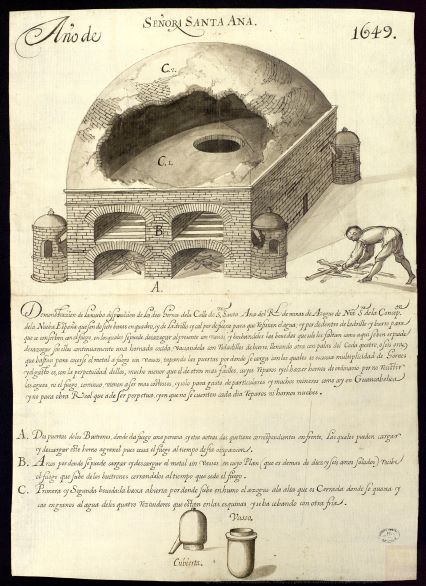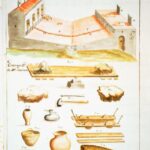
Quicksilver, or mercury, is a metal obtained from the mineral called cinnabar, which was decisive for the processing of silver, and was therefore of vital importance for the production of this metal. It was in the 16th century when Bartolomé de Medina unveiled the method of amalgamation with quicksilver, a method which was very successful and which brought about a revolution in metallurgy. The Spanish Crown obtained most of its supplies of quicksilver from the mines of Almadén in Spain and Huancavelica in Peru. Almadén’s cinnabar reserves had been exploited since ancient times. In modern times, from the beginning of the 16th century, the mines were perpetually incorporated into the Crown of Castile. Until the mid-17th century, the mines were exploited by private individuals who obtained a right granted by the Crown of Castile. From 1645 onwards, the mine returned to the hands of the State, and a process of slow reforms and the appointment of superintendents began. The upper part of the selected resource depicts the furnaces used to separate the quicksilver. From one of them starts a row of aludels (terracotta pipes) used for the condensation of the mercury vapour that ends in the condensation chamber. The lower part of the print shows the tools and implements for working and processing the quicksilver, such as a balance, pieces of metal, hammer and chisel, cart, wood for holding the baskets, a bag of badana, aludeles, earthenware vessel for storing the mercury, basket and mould for shaping. The drawing is a copy by José Antonio de Alzate y Ramírez, published by Antoine de Jussieu. Antoine de Jussieu was sent to Spain by the Duke of Orleans to collect plant species for the gardens of Paris. Together with his brother Bernard, he visited the Almadén mines in 1717 and 1719, and presented a Memoir to the Academy of Sciences in Paris. The translation of this Memoir was made by José Antonio de Alzate y Ramírez, who also copied the prints that were published in it, under the title “Observations on what is practised in Almadén in Spain to extract quicksilver and on the nature of the illnesses of those who work by Mr. Jussieu, on 15 November 1778”.
Collection: Images
Project: 2. Social and economic impact of technological revolutions in Europe., 3. Rural world and urban world in the formation of the European identity.
Chronology: XVIII
Scope: Primary Education, Secondary Education, Baccalaureate, University
Link: http://pares.mcu.es/ParesBusquedas20/catalogo/show/20643?nm
Resource type: Image
Format: Stamp
Source: Archivo General de Indias. Mapas, planos, documentos iconográficos y documentos especiales. Ingenios y muestras.
Language: Spanish
Date: 1778
Owner: María del Mar Felices de la Fuente (Modernalia)
Identifier: ES.41091.AGI//MP-INGENIOS,281
Copyright: MECD. Archivos Estatales (España)
Abstract: Print from the memoirs of Antoine de Jussieu. Aludel furnace and equipment for the distillation of mercury used in the Almadén mines.
Image
Tags





